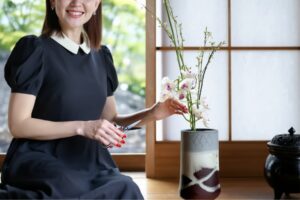Interested in Ikebana but feeling overwhelmed by the many different schools? You’re not alone! Ikebana, with its rich history as a traditional Japanese art form, encompasses various schools, each with its unique style and characteristics. The school you choose will shape your learning experience. Let’s explore the major Ikebana schools and their distinctive features to help you find the perfect match for your artistic journey.
Major Ikebana Schools and Their Characteristics
1. Ikenobo – The Traditional Pioneer
With over 550 years of history, Ikenobo is the oldest Ikebana school, originating from Rokkaku-do Temple in Kyoto. **Their signature style, “Rikka,” emphasizes maximizing natural beauty through formal arrangements.** Perfect for those interested in mastering traditional techniques and strong fundamentals.
– Focuses on Rikka style that preserves natural forms
– Ideal for learning orthodox Ikebana
– Known for simple yet powerful expressions
2. Sogetsu School – Modern Artistic Freedom
Founded in 1927 by Sofu Teshigahara, Sogetsu embraces contemporary artistic expression. **It’s perfect for those seeking creative freedom in their arrangements.** Like modern art, Sogetsu arrangements can incorporate unique materials and fit beautifully in contemporary spaces.
– Encourages free expression without rigid rules
– Creates innovative designs for modern spaces
– Welcomes incorporation of non-traditional materials
3. Ohara School – Nature’s Recreation
Established in 1895 by Unshin Ohara, this school is famous for its **”Moribana” style, which recreates natural landscapes in miniature.** If you love capturing seasonal changes and natural scenes, this school might be your perfect match.
– Specializes in landscape-inspired Moribana
– Emphasizes seasonal expressions
– Focuses on natural beauty
4. Misho School – Minimalist Beauty
Dating back to the 16th century, Misho School is known for its “Isshu-ikka” technique, creating beauty with minimal materials. **Ideal for those who appreciate minimalist design and want to create refined arrangements with few elements.
– Emphasizes minimalist expression
– Creates impact with limited materials
– Perfect for minimalist design enthusiasts
5. Koryu – Classical Tradition
Koryu represents classical Ikebana schools, known for their strict adherence to traditional forms. **Perfect for those who want to master classical techniques and appreciate structured learning.**
– Maintains strict traditional forms
– Ideal for formal technique study
– Emphasizes classical beauty
<
How to Choose Your Ikebana School

Consider these points when selecting a school:
– For traditional focus: Consider Ikenobo or Koryu
– For artistic freedom: Look into Sogetsu
– For nature-inspired arrangements: Ohara might be perfect
Summary

Each Ikebana school offers unique approaches to floral art. Choose based on your personal style preferences and artistic goals. Whether you prefer traditional or modern styles, Ikebana offers a beautiful way to express yourself through natural elements. Take the first step into the world of Ikebana by choosing the school that resonates with your artistic vision!



